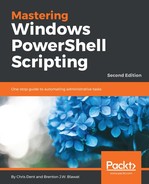Chapter 1, Introduction to PowerShell, introduces PowerShell and why it is applicable to the IT community. This chapter discusses the types of Microsoft systems that leverage PowerShell and why it's important to learn this scripting language.
Chapter 2, Working with PowerShell, talks about finding and using commands and parameters.
Chapter 3, Modules and Snap-Ins, shows how to use PowerShell modules and snap-ins.
Chapter 4, Working with Objects in PowerShell, shows how to work with objects in PowerShell.
Chapter 5, Operators, shows how to use operators to test and manipulate data.
Chapter 6, Variables, Arrays, and Hashtables, explains the different mechanisms within PowerShell that are able to store data. These include variables, hashes, and arrays.
Chapter 7, Branching and Looping, shows how to explore conditional statements and how to implement loops in PowerShell.
Chapter 8, Working with .NET, shows how to work with existing classes from the .NET framework in PowerShell.
Chapter 9, Data Parsing and Manipulation, explains different methods to manipulate simple types in PowerShell.
Chapter 10, Regular Expressions, shows the usage of regular expressions in PowerShell scripts. This will provide the user with the ability to provide quick data comparisons.
Chapter 11, Files, Folders and the Registry, explores different methods to interact with common items on the file system and registry.
Chapter 12, Windows Management Instrumentation, explores PowerShell’s ability to interact with WMI. This includes methods by which users can manipulate the WMI to obtain information pertaining to an operating system.
Chapter 13, HTML, XML, and JSON, explores the XML structure and how PowerShell can interact with XML files. This chapter will also explore how to use XML files as answer files for PowerShell scripts.
Chapter 14, Working with REST and SOAP, shows how to use REST or SOAP interfaces.
Chapter 15, Remoting and Remote Management, explores the use of Windows remoting and remote sessions to execute against remote systems.
Chapter 16, Testing, shows how to use PSScriptAnalyzer and Pester to improve the quality of your code.
Chapter 17, Error Handling, shows how to leverage PowerShell’s error handling to work with errors.
